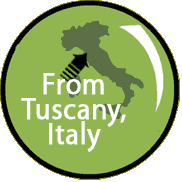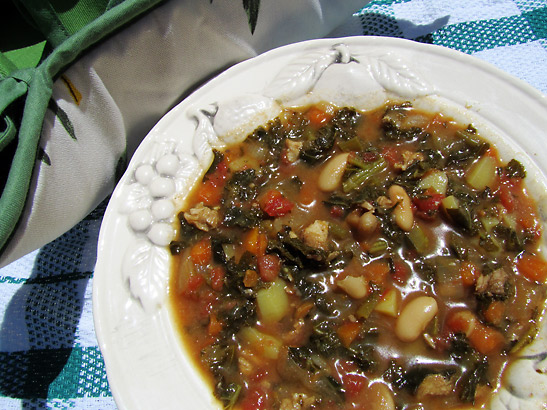 |
 |
|
 |
 |
|
Ribollita
Tuscan food reflects this honest mix of sophistication and simplicity. Olive oil, legumes, fennel and unsalted bread are standard, along with lots of vegetables, often fried. Local pig, wild boar, rabbit, pheasant and fish are usually cooked on a spit or grilled. But for me it's the soups in Tuscany that stand out. Humble, comforting, masterful. I never tire of ribollita, especially, as each Italian cook adds his or her personal touch and no two versions are exactly alike. What sets ribollita apart from other minestroni is the use of bread instead of pasta or rice. Traditionally, the soup sits overnight and the added bread dissolves into the broth as a tasty thickener when it is--ribollita--reboiled the next day. Ingredients: 1 and ½ cups (9 ounces) dried cannellini beans (or white kidney beans or fazolia) Initial Broth:
Vegetables/Bread:
Pick through beans while rinsing in colander under cold water, discarding any floaters or foreign objects. Soak according to package directions or overnight for best results. Do NOT add salt. Drain and discard liqiud. ( Approx. 3- 15-oz. cans of precooked beans may be substituted. If using canned beans, skip making the initial broth. Brown the pork bones in the olive oil, then add onions and continue with recipe.) Combine initial broth ingredients and drained beans only in sturdy large pot. (NO salt or acid or your beans will be terminally tough.) Bring to a boil slowly, reduce heat and simmer gently. Cover pot, lid slightly askew to vent steam and cook 1 to 1-½ hours or until beans are softened. In a second pot, sauté the onions in the olive oil, stirring occasionally, until they begin to color. Add garlic, salt, celery, carrots, potatoes and stir well to coat with oil. Whisk the tomato paste with a little hot water to thin, then add to vegetable mixture. Cover and cook on medium heat for 10-15 minutes, stirring to prevent sticking. Add 5-6 cups of cold water to the vegetable mixture and bring back to a boil. Add the kale. Don't worry about there being too much, it will cook down a lot. Puree about half the cooked, drained beans well and add the puree to the soup mixture. Simmer, covered, for an hour or so. If soup becomes too thick, add more water. Season to taste with salt and pepper. Remove pork bones, stripping off any bits of meat to stay in the broth. Add remaining whole beans and bread...If pressed for time, the hot soup can be ladled over a single slice of bread in each bowl. Otherwise, the bread should be crumbled and added to the pot, then reheated later in the Tuscan tradition. Most Italians add a drizzle of olive oil atop their ribollita.
|
Hi Audrey, Love your lamb shanks. --- Paul, Scottsdale AZ
Haven't been called Tad for . . .gee, maybe I've NEVER been called Tad . . . guess I'm the only one with chutzpah enough to mention Bourdain. BRILLIANT? --- Ken, Shutesbury, MA
I think we must have had an entirely different experience in the UK. (Fresh Food and Real Ale – week 1). We were up in Edinburgh and they served something called ‘Neeps & Tatties.’ The items were boiled so long that I couldn’t even recognize what I was eating. Come to think of it… I couldn’t taste them either. Later I found that Neeps’ are Turnips and ‘Tatties’ are potatoes. --- Lindy, Phoenix, AZ
My mouth was watering as I read some of your descriptions of the fantastic fare of ... England? I had always felt smug about the lowly reputation of British cuisine as this gave us at least one country with a worse culinary reputation than America's. I guess I'll have to change my views. Your article made me actually want to take a CULINARY tour of Britain. Yummy yummy yummy. --- Sandy Miner, Portland, OR Thanks for your note. Thanks to Traveling Boy I get to interview a world famous chef this week who is widely recognized as spearheading the Yummy movement in Ireland. Guess I'll have to take yet another culinary tour a little further north and check it out... (I love my job!) --- Audrey
Very interesting, mouth-watering piece by Audrey! (A McDreamy McMeel). Your web site is fascinating! --- Susie, Victoria, BC
Combining travel, food, and intelligent advice -- BRILLIANT! Your site fills a long-felt need for hungry roamers. Keep it up! It's Anthony Bourdain with reservations and CLASS. --- Tad, Boston, MA
|
![]()
Stay tuned.
This site is designed and maintained by WYNK Marketing. Send all technical issues to: support@wynkmarketing.com
|


|

































